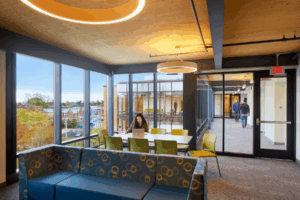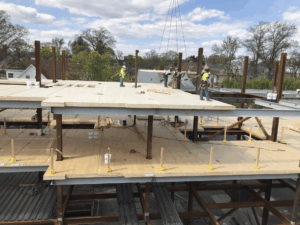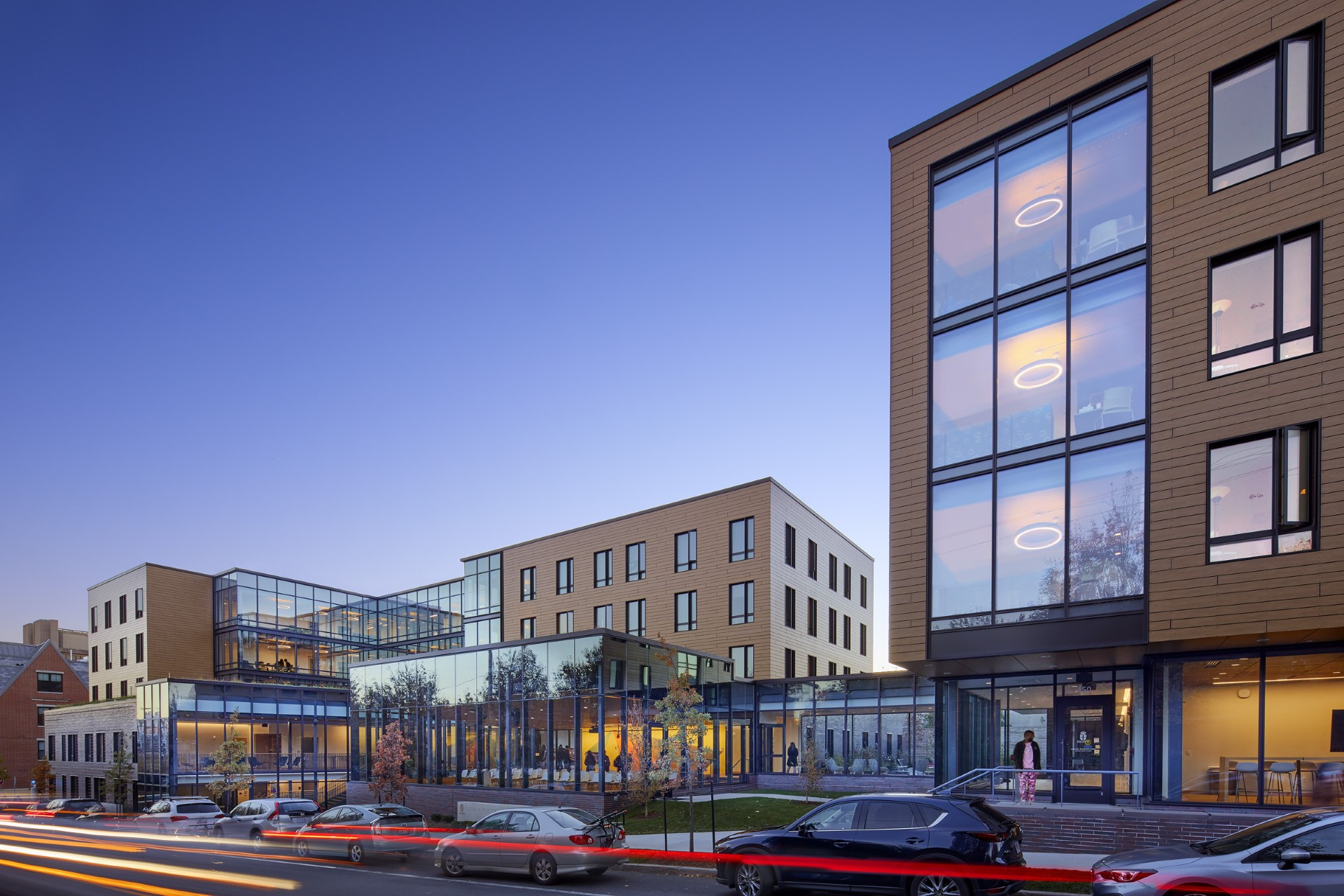Photo: The Sternlicht Commons and Brown University Health & Wellness Center reflects a shift towards a holistic approach to health and wellness. | Photo Credit: Bruce Martin
By Nancy Larson Varney Ph.D., P.E., S.E., and Nathan C. Roy, P.E.
There has been a growing shift towards a holistic approach to health and wellness that considers more than just diet and exercise. As the environment can have a profound impact on our happiness, it is easy to see why students are embracing one of Brown University’s newest buildings.
Brown envisioned a building that would bring together all aspects of health and wellness from the moment students wake up. The Sternlicht Commons and Brown University Health and Wellness Center is not only the first new residence hall to open on campus in 30 years, but it also brings together the University’s Health Services, Counseling and Psychological Services, Brown Emergency Medical Services and the health promotion program bWell. Designed by William Rawn Associates, the structure is a warm, inviting composite of timber and glass that creates a relaxing, uplifting and healing space.
Choosing the Right Materials

Photo Credit: Bruce Martin
Timber creates a calming environment that eases stress and contributes to a happier and healthier place to live and study. Paired with sunlight and floor-to-ceiling views of Pembroke Field, the result is an elevated mood and general feeling of well-being. LeMessurier, the project’s structural engineer, embraced the concept of bringing nature indoors by showcasing the building’s supporting elements.
The two buildings are joined by a glass-enclosed walkway with green spaces on either side. The North Building has three suite-style residential levels over ground-floor common spaces that include a sun-filled lounge, communal kitchen, group meeting rooms and a separate entrance lobby with bike storage. The South Building houses the University’s health and wellness spaces, including a pharmacy, ambulance bay, and bWell area on the lowest level and Health Services and Counseling and Psychological Services exam rooms and offices on the ground level. The three residential levels above offer single “pod-style” rooms with shared kitchenettes and large, open common areas. A single-story multipurpose room offers a panoramic view through three sides of full-height glass.
The ceilings of the dorm rooms and residential common spaces are cross-laminated timber (CLT) panels. Constructed of smaller boards stacked in perpendicular layers that are pressed and glued together, CLT provides significant strength, stiffness and dimensional stability. In the residential areas, CLT panels are left exposed to showcase the warmth of the timber and reduce the need for finishes. Coupled with steel framing for the gravity and lateral systems, the result is a timber-steel hybrid structure.
Structural Strategy
A steel-timber hybrid structure was selected to optimize the different structural elements. Unlike a mass timber lateral system, the steel system did not require a variance to comply with the current building code and potentially extend the construction schedule. Additionally, the first two levels of the buildings are lightweight concrete on metal deck to allow for a two-hour rated separation between residence hall and health spaces.
The design-build project, led by Shawmut Design and Construction, focused on a fast construction schedule. The use of prefabricated CLT panels increases construction speed while decreasing waste, as they are fabricated in a controlled factory, ensuring components fit together when delivered on site. The delivery of the panels is sequenced such that they can be placed straight off the truck without the need for an extensive lay-down area. Fewer crew members are needed to catch and position a panel. This process results in a solid walking surface which, coupled with fewer people on the jobsite, increases safety.
Mass Timber Considerations

Photo Credit: Shawmut Design and Construction
CLT panels have a strong and weak direction due to the lamination layout. The layers on the top and bottom of the panels are parallel to its length and define the panel’s primarily one-way spanning direction. Nordic Structures, the CLT fabricator, provided 5-ply panels that were roughly 8 feet wide, up to 51 feet long, and with a thickness of just under 7 inches. The typical layout was three spans of approximately 15 feet each, but the CLT panels also accommodated the irregular column spacing in the South Building.
A typical CLT panel to glulam beam connection uses self-tapping screws through the panel into the beam below. At Brown, the connection between CLT panels and steel beams is similar, but the screws are installed from below through the top flange of the steel beam. Along with bracing the top flange of the beams, these connections allow the steel framing to act as drag struts to the steel-braced frames and the diaphragm chords.
Without knowing the panel layout prior to designing the steel framing, the team decided to limit the minimum beam flange to allow any beam to accommodate CLT panel joints. Additionally, limitation on columns and brace locations in the health spaces resulted in an irregular grid. The flexibility with the timber-to-steel connections helped the coordination and construction processes run smoothly.
The perimeter and corners of CLT floor plates also presented unique challenges. The curtain wall wind anchors, typically connected to steel beams or plates at concrete slab edges, were screwed into the edges, or side face, of the CLT panels. Coordination was required to comply with spacing requirements and capacity reduction values for screws installed in the side face of the panel either in the end-grain or edge-grain laminations were considered.
Mass Timber Benefits
There are reasons a project team might consider mass timber construction beyond the benefits of visually exposing the timber structure. Two of the primary positive impacts of incorporating timber are related to resilience and sustainability. From supporting managed forestry, being a renewable resource, and sequestering carbon, timber construction offers many green benefits.
A recent focus on reducing embodied carbon of structures is reflected in the SE 2050 Commitment Program (SE 2050) of the American Society of Civil Engineers (ASCE).
Add all the other pieces to complete construction and this steel and timber skeleton becomes a building that reaps the biophilic benefits of wood for residents and visitors alike. The connection to nature can be seen in the reflection of trees on the glass wall of the multipurpose room and the illumination of the CLT ceilings in the common spaces of the residence halls.
Project Team
- Architect: William Rawn Associates, Architects
- Structural Engineer: LeMessurier
- Contractor: Shawmut Design & Construction
- Steel Fabricator: Ocean Steel & Construction
- CLT Fabricator: Nordic Structures
- Concrete Contractor: Marguerite Concrete Contractors
Ausutors:
Nancy Larson Varney, Ph.D., P.E., S.E., is an associate teaching professor at Northeastern University, formerly an associate with LeMessurier. She can be reached at [email protected].
Nathan C. Roy, P.E., is a principal with LeMessurier. He can be reached at [email protected].


